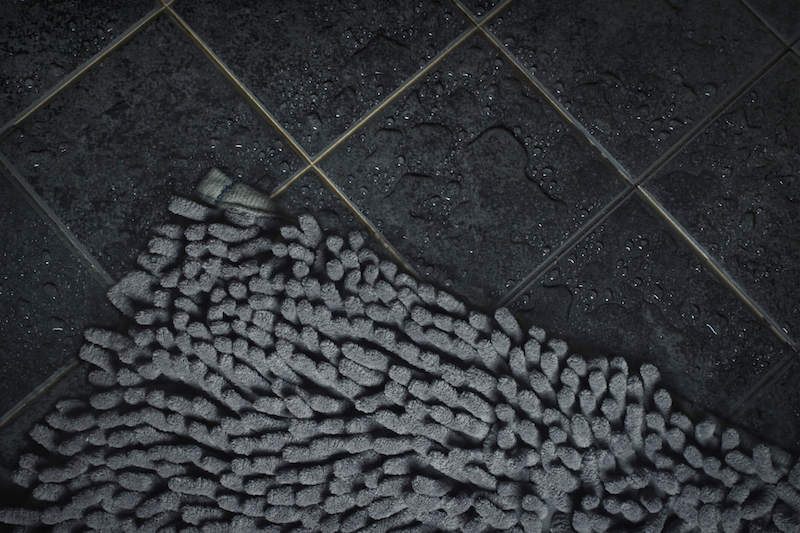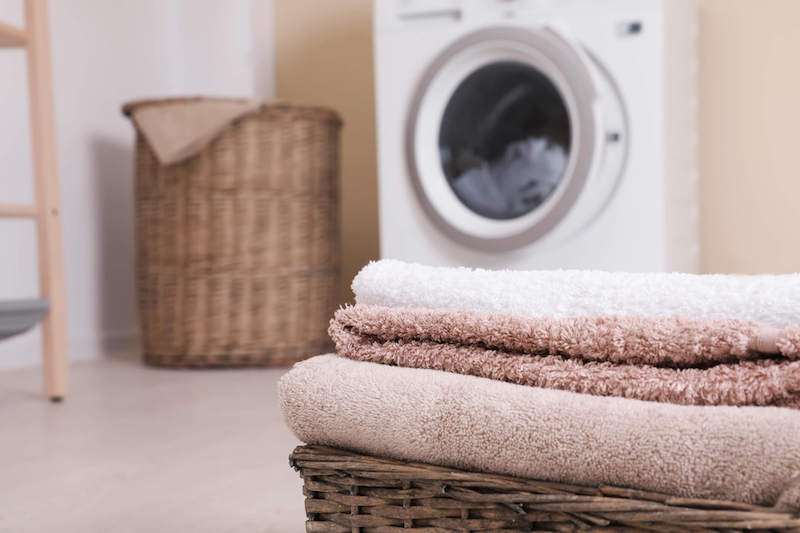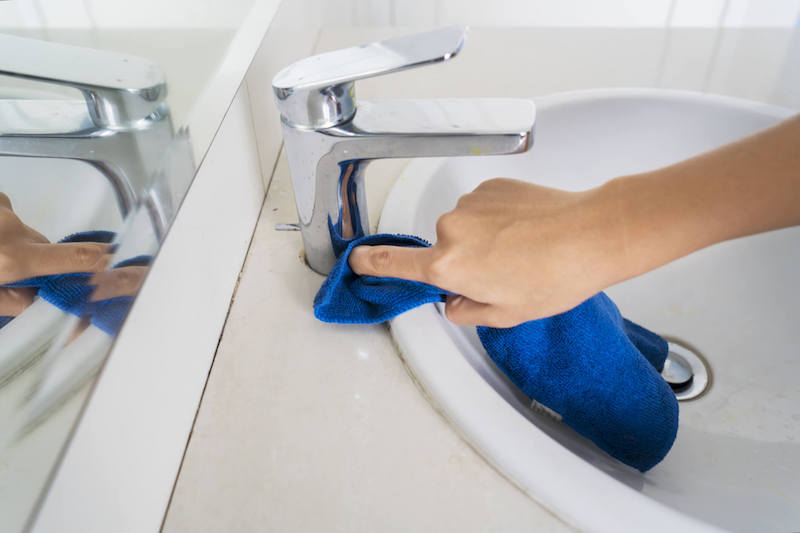Bathrooms aren’t always the cleanest of places. Probably because they’re the rooms we frequent to get cleaned up ourselves! To be honest, keeping these rooms spotless is probably at the top of the list of chores we all hate the most. Without proper care and maintenance, though, a certain fungus can slip right in and cause serious bathroom catastrophes, such as a moldy bath mat.

That’s not exactly what we want hanging out inside of one of our favorite rooms in the house! Just imagine stepping out of a nice, refreshing shower and straight into a growing mold colony. Icky...
Plus, a moldy bath mat opens the door for more mold growth opportunities in additional areas of the bathroom or other rooms in the house. The good news is that there are several steps you can take to ensure this fungus among us doesn’t settle in and start to colonize that handy water-absorbing accessory. That way, our bathroom oases can remain safe and clean.
Why the Bath Mat?
It’s pretty simple! A bath mat offers the perfect conditions for mold to grow if a lucky mold spore stumbles upon it. But, before we get into that, let’s back up a little bit.
There are over 100,000 species of mold identified so far, and they all reproduce by creating microscopic particles called spores.¹’² These spores are released into the air and travel wherever that current takes them. If a spore lands in a cozy place that meets all of its needs, it will settle in and begin to grow. Kind of like how early colonizers set off into the world to find goods and new places to live. They would only remain in an area if they found the necessities they needed to survive.
When it comes to spores, these hardy little particles only need four key components to start creating a moldy home. Without these present, they’ll just stick to the surface and remain invisible to the naked eye.
These four ingredients for life include: ³
- Oxygen (they need very little)
- Temperature (most spores prefer temperatures between 40 and 90 degrees Fahrenheit, but some can survive in extremes)
- Food (they’re like teenagers, they eat anything)
- Moisture (typically the missing piece of the puzzle)
A mold colony can begin if these components are present for at least 24 hours when a spore lands on a surface.

Tying In The Bath Mat
When it comes to bathrooms in general, they’re phenomenal places for a mold spore to end up. There are all kinds of yummy (for mold) particles, a warm and cozy atmosphere, plenty of oxygen, and an abundance of watery opportunities. The bath mat, specifically, often offers up these conditions if it’s not taken care of properly.
Just think about it: a) the material of the mat can trap all kinds of particles like dust, dirt, and skin cells, and b) its job is literally to soak up and retain water after a shower or bath so that the bathroom floor doesn’t get slippery and full of puddles. It's excellent for preventing bathroom mishaps, but not so good for preventing mold growth!
If a mold spore happens upon this water-logged, particle-filled mat, it will think it has won the dream home lottery. Before you know it, you’ll have a mold colony on your hands, oftentimes growing undisturbed for some time if the mat isn’t picked up and cleaned frequently. That’s a serious no-no for your health.
Mold The Menace
When a mold spore settles down and begins to grow, it immediately begins releasing more spores into the air. Some species of mold can also produce microscopic toxins called mycotoxins when they feel threatened. ⁴ A new mold spore finding this bath mat oasis and beginning to grow, for instance, can make a colonized mold feel under attack and trigger the production of these tiny toxins.
Both the spores and toxins are bad news for our health. When we encounter a couple of these particles throughout the day, it’s typically no big deal. Our immune systems will deploy and get rid of them ASAP. When all of those particles are trapped within the confines of the bathroom or the walls of a home, that’s when things get dicey.
The immune system will attempt to fight off this high volume of particles, but it’s not always going to be successful. Sometimes it will get bogged down, malfunction, or simply not be able to keep up with so many foreign particles.
Researchers are still attempting to determine exactly how mold exposure can affect health, but it’s a tricky subject to nail down. Genetics, length of exposure, presence of mycotoxins, species of mold, and immune system status all play a role. Those with the gene HLA-DR, for example, aren’t able to fight off the presence of mold particles in the body and will experience symptoms much more quickly and to a greater extent. Individuals with a compromised or developing immune system are also more susceptible to developing reactions. ⁵’⁶’⁷’⁸

Symptoms of mold exposure can include:
- Runny nose
- Cough
- Digestive problems
- Rashes
- Brain fog
- Chronic Fatigue
- Neurological issues
- Respiratory problems
The truth is, everyone’s reaction to indoor mold growth is different. Some people may develop 30 symptoms, and some may have a runny nose. Mold’s ability to trigger a reaction, though, is enough reason to actively work towards preventing it from growing in the first place. This includes avoiding issues such as a moldy bath mat.
Preventing A Moldy Bath Mat
Between the ick factor of stepping into a mold colony and the potential side effects of exposure, preventing a moldy bath mat should be high on the list of bathroom chores. On the bright side, avoiding a moldy mat doesn’t require a huge amount of work. Simply adding a few extra steps to your daily and weekly bathroom routine will work wonders for keeping these water-absorbing items clean and fungus-free.
Actions to help prevent a moldy bath mat include the following.
1. Drying It Out
Bath mats are meant to absorb water, but if they’re constantly wet, that pretty much creates an open invitation for mold growth. After you get out of the shower, make sure to hang up that non-slip accessory so that it can thoroughly dry after use. A towel rack is a great option for ensuring this mat gets completely dry.
Then, place it back down when you or your family is ready to take a shower or bath! Remember, all it takes is 24 hours for a mold spore to begin growing, so the goal is to completely dry the mat within that time frame.

2. Keeping It Clean
Is the bath mat on your list of frequently washed items in your home? It should be! Cleaning these bathroom accessories helps remove any present mold spores and removes food sources they can use to start growing.
At least once a week, wash your bath mat with an EPA-approved cleaning product like the EC3 Laundry Additive. This cleaning product uses natural botanicals to get rid of any mold particles and its byproducts from porous items like bath mats. Make sure to check the manufacturer’s label on your mat, though!
Some mats have to be hand-washed and can’t be thrown into the washing machine. The manufacturers will be able to give you the best cleaning instructions for your specific mat. After washing, dry the mat completely before placing it back in the bathroom.
Another cleaning tip is to frequently use a HEPA vacuum cleaner on your bath mat. This will remove any particles or rogue spores that are hanging out on the surface.
3. Replacing It On Schedule
A well-worn bath mat can lead to issues such as cleaning and drying difficulties, which is pretty much an extended invitation for mold growth. To help prevent this, make sure to replace your trusty bath mat with a new one when the time arises.
The good news is that bath mats are built to last, so you can wait for about two years before hunting down a new one. The more frequently replaced, the better, though. If you happen to see a mat that calls your name, mold prevention can be the excuse you need to take it home with you!

4. Creating an Anti-Mold Growth Bathroom Atmosphere
A great way to help prevent a moldy bath mat is to actively work towards preventing a moldy bathroom. This includes cleaning frequently, wiping up puddled water, cracking the door and turning on the exhaust fan while showering, and immediately drying any frequently wet items like towels.
The goal is to limit the amount of food and water that any spore can use to start growing. Once mold growth begins in the bathroom, the chance of another moldy problem developing in another location (like a moldy math mat) skyrockets.
5. Maintaining Low Indoor Humidity
Removing moist air from inside of a bathroom is crucial in helping avoid mold growth. Air that’s packed with moisture can lead to things like a moldy bath mat by preventing it from drying out completely or by triggering condensation that a mold spore can use for growth. Not to mention, wet air, in general, can provide just enough moisture for a mold spore to survive.
To reduce these opportunities, maintain the EPA’s suggested humidity level of 30–50 degrees at all times. ⁹ It can be a little more work in a water-filled room like the bathroom, but it’s worth it to avoid indoor mold growth! To achieve drier air, make sure to use the exhaust fan every time the bathroom is in use and focus on creating air circulation, either by opening a window or cracking the bathroom door. This will replace that water-filled air with drier air from outside of the bathroom. Make sure to keep the fan running for at least 30 minutes to an hour after you’re finished.
If you just can’t kick that wet air, consider investing in a dehumidifier for this water-packed room. This machine will help pull out any additional water that air circulation alone can’t remove.
Collectively, these simple actions will help prevent a mold spore from settling in and creating a moldy bath mat.
Oh No! There’s A Moldy Bath Mat!
Sometimes, no matter what you do, mold will just slip in and start to grow. It could be from accidentally forgetting to hang the mat up or a few days of humid air inside of the bathroom. This fungus is just seriously persistent!
If you discover a moldy bath mat in your bathroom, it’s best to just throw it away in the garbage outside your home and purchase a new one. The roots of the colonized mold can dig deep inside of the mat and can escape any cleaning and decontaminating you attempt to do, and byproducts like mycotoxins are particularly difficult to get rid of. It’s best to just err on the side of caution.
Throwing it away means you can be 100% positive that there isn’t hidden mold growth that managed to survive deep within the fibers of the mat. Plus, it’s an excuse to get that awesome bath mat you’ve been eyeing on Amazon that keeps popping up in your recommended items!

It’s a win-win!
Not Today, Mold!
Mold prevention is all about creating better awareness and adding things like bath mat maintenance to our everyday routines. Little steps throughout the day can work wonders to help prevent things like a moldy bath mat from existing inside of your bathroom while you’re getting ready for work in the morning or bathing your child at night.
As a society, we rarely consider the effect our indoor environment has on our health. When you think about it, though, we spend a majority of our time inside our homes. Just think of how many times a day you walk into your bathroom! Working to create a safer home environment with better indoor air quality helps to ensure you and your family can live healthy, happy lives free from indoor mold growth.
Still Have Questions?
A member of our team is here to help! Click on “Get Started ➤” below to book a consultation with a member of the HOMECLEANSE team. We have a few quick questions that will help us put together a roadmap to solve or prevent all of your mold problems.
Two minutes of your time could lead to better health for you and your family.
Citations:
- Environmental Protection Agency. (n.d.). Mold. EPA. Retrieved from https://www.epa.gov/mold.
- Centers for Disease Control and Prevention. Basic facts about mold and dampness. Centers for Disease Control and Prevention. Retrieved from https://www.cdc.gov/mold/faqs.htm.
- Lstiburek, J., Brennan, T., & Yost, N. (2002, January 15). Rr-0208: What you need to know about mold. Building Science Corporation. Retrieved from https://www.buildingscience.com/documents/reports/rr-0208-what-you-need-to-know-about-mold/view.
- World Health Organization. (n.d.). Mycotoxins. World Health Organization. Retrieved from https://www.who.int/news-room/fact-sheets/detail/mycotoxins.
- Environmental and Occupational Health Assessment Program, & Environmental and Occupational Health Assessment Program, & Health Science Section, Mold Basics for Primary Care Clinicians (2009). Hartford, CT; Connecticut Department of Public Health. , H. S. S., Mold Basics for Primary Care Clinicians 1–10 (2009). Hartford, CT; Connecticut Department of Public Health.
- Curtis, L., Lieberman, A., Stark, M., Rea, W., & Vetter, M. (2004). Adverse health effects of indoor molds. Journal of Nutritional & Environmental Medicine, 14(3), 261-274.
- Bush, R. K., Portnoy, J. M., Saxon, A., Terr, A. I., & Wood, R. A. (2006). The medical effects of mold exposure. Journal of Allergy and Clinical Immunology, 117(2), 326-333
- Fisk, W. J., Lei-Gomez, Q., & Mendell, M. J. (2007). Meta-analyses of the associations of respiratory health effects with dampness and mold in homes. Indoor air, 17(4), 284-296.
- EPA. (n.d.). A Brief Guide to Mold, Moisture, and Your Home. EPA. Retrieved from https://www.epa.gov/mold/brief-guide-mold-moisture-and-your-home#tab-6.
Must-Have Indoor Air Quality Tools
-

EC3 Laundry Additive
Add EC3 to every rinse cycle to rinse away mold, bacteria and musty odors from...
-
$23.00 Shop Now -

Intellipure Compact Air Purifier
Small in size, but delivers powerful results, reducing airborne microorganisms like mold, viruses, and bacteria.
-
$649.00 Shop Now -

Intellipure SuperV Whole House Air Purifier
Turn your HVAC into a filtration system, removing 99% of ultrafine particles including airborne mold,...
-
Price range: $2,000.00 through $2,995.00 Shop Now -

HomeCleanse Cleaning
Take your cleaning to the next level buying all the tools we use to keep...
-
Price range: $299.00 through $549.00 Shop Now -

Mold & Bacteria Contents Cleaning
Remove harmful pollutants that accumulate in the dust of your home. (Options available for renters...
-
Price range: $99.00 through $349.00 Shop Now -

EC3 Mold Solution Concentrate
Micro Balance EC3 Mold Solution Concentrate is a natural botanical that removes mold spores, bacteria,...
-
$33.00 Shop Now -

Industry-Leading Intellipure Ultrafine 468
The Intellipure® Ultrafine 468 features our proprietary DFS technology, which traps and eliminates potentially harmful...
-
Shop Now -

The Dust Test
The Dust Test is a comprehensive at-home test that helps you identify mold and toxins...
-
$299.00 Shop Now -

EuroClean 4 Gallon Hepa Vacuum
The Euroclean GD930HSP is a 4 Gallon Dry HEPA Vacuum that meets the EPA's standards...
-
$849.00 Shop Now -

AprilAire E080 Professional Dehumidifier Bundle
Includes all the dehumidifier accessories you will need. Our Aprilaire E080 comes with a drain...
-
$1,524.99 Shop Now
